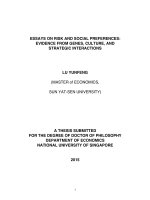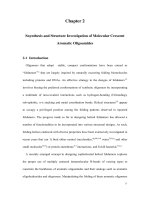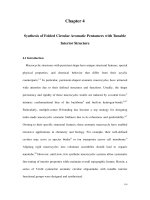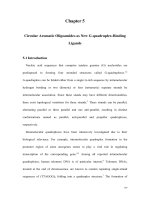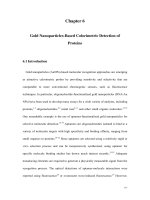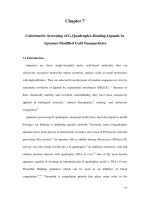Making meanings, creating family intertextuality and family interaction
Bạn đang xem bản rút gọn của tài liệu. Xem và tải ngay bản đầy đủ của tài liệu tại đây (768.22 KB, 246 trang )
Tai Lieu Chat Luong
Making Meanings,
Creating Family
This page intentionally left blank
MAKING MEANINGS,
CREATING FAMILY
Intertextuality and Framing in Family Interaction
Cynthia Gordon
1
2009
3
Oxford University Press, Inc., publishes works that further
Oxford University’s objective of excellence
in research, scholarship, and education.
Oxford New York
Auckland Cape Town Dar es Salaam Hong Kong Karachi
Kuala Lumpur Madrid Melbourne Mexico City Nairobi
New Delhi Shanghai Taipei Toronto
With offices in
Argentina Austria Brazil Chile Czech Republic France Greece
Guatemala Hungary Italy Japan Poland Portugal Singapore
South Korea Switzerland Thailand Turkey Ukraine Vietnam
Copyright # 2009 by Oxford University Press, Inc.
Published by Oxford University Press, Inc.
198 Madison Avenue, New York, New York 10016
www.oup.com
Oxford is a registered trademark of Oxford University Press
All rights reserved. No part of this publication may be reproduced,
stored in a retrieval system, or transmitted, in any form or by any means,
electronic, mechanical, photocopying, recording, or otherwise,
without the prior permission of Oxford University Press.
Library of Congress Cataloging-in-Publication Data
Gordon, Cynthia, 1975–
Making meanings, creating family : intertextuality and
framing in family interactions / Cynthia Gordon.
p. cm.
Includes bibliographical references and index.
ISBN 978-0-19-537382-0; 978-0-19-537383-7 (pbk.)
1. Communication in the family—United States—Case studies.
2. Discourse analysis—United States. I. Title.
HQ536.G667 2009
306.87010 4—dc22
2008042017
2 4 6 8 9 7 5 3 1
Printed in the United States of America
on acid-free paper
For my parents
Karen Gordon
and
Greg Gordon
This page intentionally left blank
Acknowledgments
T
he research project on which this book is based was funded by the
Alfred P. Sloan Foundation (grant no. 99010-7 to Deborah Tannen and Shari Kendall and grant no. B2004-20 to Deborah Tannen,
Shari Kendall, and Cynthia Gordon). I thank project officer Kathleen
Christensen and the Sloan Foundation for their support of this project.
I also thank fellow researchers Deborah Tannen and Shari Kendall, who
were such a pleasure to work with. Participating in this project has
profoundly affected my development as a scholar, and I am extremely
grateful to have had this opportunity. I am also grateful to the other
research team members on the project: Philip LeVine, Sigrid Norris,
Alla Tovares, and especially Alexandra Johnston, who helped me identify a number of key examples of intertextuality.
I owe a great debt to Deborah Tannen, whose scholarship, continual support and enthusiasm, mentorship, and teaching has deeply influenced my research, my writing, and my thinking about discourse
analysis, family interaction, and the role of language in everyday life.
I cannot thank her enough for the careful attention she has given my
work, including my dissertation, for which she served as director at
Georgetown University; the articles based on it which are published
elsewhere; and now this book as well. I thank her for the guidance and
reassurance she has continually provided; and for the example she sets as
a scholar, teacher, and mentor. I thank Heidi Hamilton and Deborah
viii
Acknowledgments
Schiffrin for the support, guidance, and advice they provided me as a
graduate student and beyond, and for insightful comments they
provided on portions of individual chapters. I am especially thankful
to Heidi Hamilton for her comments regarding my conceptualization
of intertextuality. I am also indebted to Najma Al Zidjaly, Sylvia Chou,
Elisa Everts, Andy Jocuns, Miriam Locher, Karen Murph, and Alla
Tovares for providing me with feedback during the early stages of my
analyses. My indebtedness to Deborah Keller-Cohen goes further back;
I am thankful for her continued support since my time as an undergraduate at the University of Michigan, where I was first introduced to
discourse analysis.
I owe thanks to the Sloan Foundation for supporting the Center for
Myth and Ritual in American Life (the MARIAL Center) at Emory
University; much of this book was completed while I was a postdoctoral
fellow there. I thank the center’s director, Bradd Shore, who also served as
my mentor, as well as the staff, faculty, and fellows who made it such a
wonderful place to work. I especially thank Robyn Fivush for deepening
my contemplation of family narratives; Bradd Shore for helping me think
about family ritual and the complex nature of play in family talk; and
Kristin Celello and Drew Whitelegg for providing valuable feedback on
individual chapters and data extracts. Through my work at Georgetown
and Emory, I was able to connect with researchers at the Center for the
Everyday Life of Families (CELF) at the University of California, Los
Angeles, also funded by the Sloan Foundation. I am very appreciative of
the scholarship of this group, as well as the conversations I have had with
individual members, particularly Charles Goodwin, Marjorie Harness
Goodwin, Elinor Ochs, Karen Sirota, and Leah Wingard.
Members of various audiences made helpful comments regarding
specific analyses I presented on different occasions; these audiences
include faculty and fellows of the MARIAL Center, members of the
Emory University Program in Linguistics, the University of Michigan’s
Sociodiscourse group, and Wayne State University’s Department of
English, as well as audiences at various professional conferences. I am
grateful to have had the opportunity to present my work to such diverse
groups and for the feedback I received. I especially benefited from
conversations with Philipp Angermeyer, Benjamin Bailey, Richard
Buttny, Donal Carbaugh, Kristine Fitch, Barbara Johnstone, Debra
Spitulnik, Inge Stockburger, Susan Tamasi, Anna Marie Trester, and
Donald Tuten. I am also grateful for comments on individual chapters
Acknowledgments
ix
provided by Carl Bon Tempo and Stanton Wortham, and for those
I received from two anonymous reviewers on the entire manuscript. In
addition, Najma Al Zidjaly and Alla Tovares carefully read my manuscript and provided not only many helpful suggestions but also moral
support; for this I am very thankful.
I am grateful for the families who participated in this study; their
generosity, courage, and good humor in allowing recorders and a team
of sociolinguists into their lives made this study possible. I also thank the
staff at Oxford University Press for their help and support in the
production of this book.
Studying family discourse has made me all the more aware of how
much my own family means to me, and all the more appreciative of the
various intersecting circles of individuals that constitute it. I thank Dan
Beckett, my partner in life, for his love, support, and wit; for his
comments on this manuscript; and for putting up with the “shenanigans” that being married to an academic entails. I am thankful for
Frances, who brings Dan and me much joy on a daily basis. I am
thankful for my sisters and symbolic sisters—Sarah Gordon, Whitney
Gordon, Najma Al Zidjaly, Alla Tovares, Lydia Springer, Isha Youhas,
Sarah Foley, and Heather Whitten—with whom I have shared much
coffee, chocolate, and conversation over the years. I am also thankful
for the Becketts, who have always treated me like a member of their
family, and for my stepmother, Dina Giurini-Gordon, whose good
humor fits right in. Finally, most of all, I am grateful to my parents,
Karen Gordon and Greg Gordon, for each creating a family I love, for
helping me develop an open mind and an appreciation of language, and
for teaching me how to laugh.
This page intentionally left blank
Contents
1. Introduction: Intertextuality and Framing in Family Discourse 3
2. “All Right My Love?” “All Right My Dove”: Extreme
Intertextuality and “Framing Family” 26
3. “Tell Uncle Noodles What You Did Today”: Intertextuality,
Child-Centered Frames, and “Extending Family” 76
4. “You’re the Superior Subject”: Layering Meanings by Creating
Overlapping and Embedded Frames 115
5. “Kelly, I Think That Hole Must Mean Tigger”: Blending Frames
and Reframing in Interaction 157
6. Conclusion: Intertextuality, Framing, and the Study of Family
Discourse 189
Postscript: “Old Habits Never Die, They Just Mutate” 200
Appendix: Transcription Conventions
Notes 205
References 211
Index 225
203
This page intentionally left blank
Making Meanings,
Creating Family
This page intentionally left blank
one
Introduction
Intertextuality and Framing in Family Discourse
“you just pop them in”: a fieldwork
narrative
On the morning of March 8, 2000, I arrived at Janet and Steve NeeleyMason’s suburban townhouse around 11 A.M.1 It was my second day of
observing Janet going about her daily life as if she were not being
observed by a sociolinguist. After accompanying Janet to pick up the
couple’s nearly three-year-old daughter, Natalie, from her Montessori
preschool, I went back home with them to eat lunch and observe them
eating lunch. Natalie, a very verbal child not used to being observed,
repeatedly tried to engage me in conversation. At one point during
lunchtime, I was eating grapes I had brought with me when Natalie
commented, “You just pop them in.” I agreed, though I was not
entirely sure what this was supposed to mean, or why she had said
it to me (other than to talk). Nevertheless (or perhaps because of this),
I later scribbled the sentence into my field notebook, following it with a
question mark.
This family had participated in a study focusing on everyday family
discourse. As part of their participation in this sociolinguistic study,
Janet and Steve had carried digital audiotape recorders with them for
one week (February 23–29, 2000), recording nearly continuously
throughout each day at home and at work. The purpose of my visit
3
4
Introduction
that Wednesday in March was so that I could see where the family lived,
where Janet worked, and what this family’s daily life “looked like,”
which would help me make sense of Janet’s tapes when I listened to
them and logged their contents.
Later that same week, I began listening to Janet’s audiotapes,
finding out what her daily family life sounded like. I was listening to a
lunchtime conversation between Janet and Natalie that was recorded
on Thursday, February 24 when I heard a familiar string of words
(transcription conventions appear in the appendix; underlining is used
to highlight repeated words that are analytically in focus):
Natalie: Um,
can I share those grapes?
Janet:
Sure!
Natalie: First of all they have to be peeled.
Janet:
<laughs>
I’m not peeling grapes!
Natalie: They’re good—
Janet:
They’re good when you just pop them in.
Remember how we did the other day?
Mm.
Natalie: They’re good with skin,
see?
Janet:
Mhm.
Natalie: They’re good with skin.
Janet:
Yeah.
Natalie: Yeah.
And you don’t even have to peel.
Janet:
That’s right,
you just pop them in.
Natalie: You just pop them in!
Like that.
[Yeah.]
Janet:
[Delicious.]
Natalie: (Yeah).
Janet:
<laughs>
The moment I heard this interaction, Natalie’s comment to me as I ate
grapes the day of my visit, “You just pop them in,” took on a new
Intertextuality and Framing in Family Discourse
5
meaning. Natalie was not simply observing that I was eating grapes. She
was drawing on “prior text” (Becker 1995) and using her memory to
recall a shared interaction (and likely interactions) with her mother
on the topic of how to eat grapes. Natalie was recycling her mother’s
words in a conversation with me, commenting on the fact that I was
eating grapes the way her mother did, and the way her mother thought
was best (without peeling them), using her mother’s exact words to do
so. Natalie’s comment suddenly made sense in a new way.
purpose of this book
In what follows, I examine linked family interactions such as these
everyday, mundane conversations about grapes—as well as others
with greater symbolic significance—to explore how repeating words,
phrases, paralinguistic features, and speech acts across interactions serves
as a means of creating meanings, and, indeed, of creating family itself. In
other words, I investigate how what has been called “intertextuality”
(Kristeva 1980 [1967]) is vitally important to meaning- and familymaking, specifically, how intertextuality serves as a resource for both
making meanings in interaction and binding members of a family
together into a distinctive social group. The notion of intertextuality
has received increasing attention in discourse analysis and sociolinguistics, linguistic anthropology, communication, and related fields. I contribute to the dialogue on this topic by analyzing intertextuality as it
manifests in interaction and by showing how it relates to framing, an
interdisciplinary theory of meaning-making. The analyses I present in
the chapters that comprise this book have two primary aims: (1) to
elucidate the vital role of intertextuality in family conversations, specifically pertaining to how family members use intertextual repetition to
construct themselves as a social group and to create meanings in interaction; and (2) to demonstrate how intertextuality and framing, two
powerful notions that have been applied widely (and largely independently) across disciplines, are best understood as fundamentally
interconnected.
This study is thus about families. I examine family conversations
primarily from an interactional sociolinguistic perspective to investigate
how individuals use language in everyday family life to actually construct
their families—to create shared meanings and craft the group’s culture.
6
Introduction
More specifically, I analyze the talk of three families that recorded their
own conversations for seven to fourteen days as part of their participation in a family discourse study undertaken at Georgetown University, the
Work and Family Project.2 This project, funded by the Alfred P. Sloan
Foundation, was designed to examine the role of verbal interaction in the
everyday lives of middle-class dual-income American families. In particular, it was designed to investigate how parents linguistically manage the
multiple demands of family and work and constitute their parental and
professional identities through talk; a variety of family and workplace
conversations was captured as a means of exploring these issues.
This book is also a study of the repetition and intertextuality that
characterize family conversations. It is about why family members
repeat words and phrases that they and other family members have
said before—in some cases tens or scores (or possibly hundreds, even
thousands) of times before—instead of saying something “new,” and
in what ways and situations they do so. As Deborah Tannen (2007
[1989]:47) writes—deliberately illustrating repetition while also pondering it—“Why is there repetition in conversation? Why do we waste
our breath saying the same thing over and over?” In exploring these
questions in the family context, I highlight the role of repetition in two
fundamental human processes—meaning-making and social group
construction—by analyzing naturally occurring conversations.
The three families whose conversations I examine are alike in some
notable ways—all are dual-income, American-born, roughly middleclass, white, and live in the metropolitan Washington, DC, area; the
parents are highly educated, having at least a bachelor’s degree; all
families have one child under age five.3 They are also distinctive from
one another; in listening to the recordings, I, like the other researchers,
was struck by how each family seemed to be its own world, with its
own ways in which family members use language. This informal observation, as it turns out, is consonant with prior research (not focusing on
language) suggesting that every American family constitutes its own
“little world” (Luckmann 1970) or “universe” (Gillis 1996).
However, regardless of the perceived variation among these
families, their discourse is (of course) not intended to represent that of
all families, or even the talk of all families that are demographically
similar. I present a qualitative case-study analysis of three families’
conversations, with particular attention paid to one family that serves
as the book’s focal point—the family whose interactions in many ways
Intertextuality and Framing in Family Discourse
7
inspired my thinking about intertextuality: the Neeley-Mason family,
consisting of Janet, her husband, Steve, and their daughter, Natalie.
I focus on this family for several reasons. First, I wanted to explore
one family’s discourse in depth, giving a “thick description” (Geertz
1973) while using the others as points of comparison, rather than give a
broad overview of all three families’ discourse. Second, methodological
considerations played a role. This family recorded the most, and the
most consistently, thus providing what I view as the richest data set for a
study of intertextuality; the Neeley-Masons even hooked up a recorder
to their home phone. Third, I was particularly drawn to this family’s
remarkable good humor and playfulness as well as the ways they
symbolically invited non-family members into their family. I wanted
to learn more about how members of this family used language in
making meanings, in creating themselves as a social group, and in
extending their “familyness”—including their family language or
“familylect” (Søndergaard 1991)—to other people in their lives. In
presenting an in-depth examination of the discourse of one family,
and using the talk of two others for comparative purposes, I identify,
describe, and offer interpretations of intertextual repetition by integrating theoretical perspectives of intertextuality and framing. In so doing,
I also contribute to the ongoing exploration in linguistics, communication, and related fields of how social groups and meanings are created
through talk.
intertextuality and framing as theory
Intertextuality
Natalie repeating her mother’s words by saying “You just pop them in”
in conversation with me, the linguistic fieldworker observing her, is not
unique; the conversations that make up our social worlds are filled with
repetition. Indeed, research in discourse analysis has illustrated that
repetition—of words, phrases, syntactic structures, ideas, and so on—
is prevalent in conversations across a variety of contexts, in literary
discourse, and in the media.4 Such repetition serves to generate links
not only within but also between various written and conversational
texts; it creates what Julia Kristeva (1980 [1967]) calls intertextuality in
her presentation and interpretation of literary theorist M. M. Bakhtin’s
8
Introduction
work on dialogicality (1981, 1984, 1986). Kristeva (1980 [1967]:66) describes intertextuality in metaphorical terms: “any text is constructed as a
mosaic of quotations; any text is the absorption and transformation of
another.” As constructing a mosaic is a creative process in which bits
and pieces from here and there are selected, adjusted, and fitted together
to create something “new,” so too is repeating. In A. L. Becker’s (1995)
words, “prior text” is continually “reshaped” in interaction in various
ways; moreover, this is what comprises language use or what he calls
“languaging.” Thus, repetition and intertextuality are fundamental parts
of communicating in general. Importantly, the theory of intertextuality
captures the idea that the meaning-making process extends beyond
individual conversations or texts. In what can be viewed as an early
discourse analytic study of intertextuality, Tannen (2007 [1989]) analyzes repetition, both within and across interactions, as a fundamental
meaning-making strategy in conversational discourse. As Bakhtin
(1986:69) explains, any speaker “is not, after all, the first speaker, the
one who disturbs the eternal silence of the universe.” Current uses of
language always hearken back to those prior, giving all discourse an
intertextual (or, in Bakhtin’s words, dialogic) dimension, whether or
not speakers intend to do so.
The dialogic dimension of language is highlighted when a speaker
uses the words of another person intentionally to create what Bakhtin
(1986) refers to as “double-voiced words.” These are words that both
refer to a referential object or event in the current interaction and are
directed toward the other person’s prior discourse. The speaker shapes
the words so they are (intended to be) heard with metaphorical “quotation marks” (Morson & Emerson 1990), enabling him or her to
comment on them in some way, such as to show agreement or disagreement, admiration or contempt. In other words, the speaker takes
an evaluative stance toward the words he or she is reshaping.5 It is
possible that Natalie’s utterance about grapes fits into this category:
Natalie perhaps voiced her mother’s words so that she could show her
mother—who could have overheard our conversation, as she was in the
same room—that she now endorsed those words and agreed that grapes
are best eaten unpeeled. Even more compelling examples of doublevoicing in family interaction occur when an adult speaker repeats a
spouse’s words as a means of teasing or gentle mocking, as analyzed in
chapter 4.
Intertextuality and Framing in Family Discourse
9
Whether intended or not, all words that are repeated necessarily
have, to some extent, this “twofold direction” (Bakhtin 1986:185). This
is so because in repeating the words of others—even verbatim, as in
direct quotation—speakers fundamentally alter them as they use them
for their own purposes in new contexts. Tannen’s (2007 [1989]) introduction of the term “constructed dialogue” as an alternative for the
term “reported speech” highlights the creative, poetic, and evaluative
nature of creating dialogue through doing what many think of as rote
“repeating” or “reporting” (hence her introduction of the new term).
Scholars such as M. H. Goodwin (1990), Buttny (1997, 1998), and Holt
(2000) have also demonstrated how speakers use a range of features—
such as prosody, voice quality, volume, and gesture—to evaluate and
thereby take stances toward so-called reported dialogues.6 In one sense,
as Becker (1994:26) explains, repeating can be described as “speaking
the past”; however, “there is always something of the present, some
variable of the communicative act that is free to express the now.” In
a similar spirit, Tannen (2007 [1989]) emphasizes that all words have a
history; indeed, she cites the works of both Bakhtin and Becker in
stating that words are “given to us by previous speakers, traces of whose
voices and contexts cling inevitably to them” (100).
In repeating (and “reporting”), interlocutors reshape and recontextualize both within texts (intratextual repetition) and across texts
(intertextual repetition) to perform a variety of functions and create a
range of meanings, a number of which are present in the family
discourse data set I examine. For instance, studies in linguistics and
discourse analysis suggest that repetition can serve to emphasize, joke,
play, mock, create rapport, clarify, and confirm.7 Furthermore, repetition can even serve a means of orchestrating action, as M. H. Goodwin
(1990) finds in her analysis of “instigating” practices among girls. What
function(s) repetition accomplishes in interaction depends on a number
of factors, including (but not limited to) the situational context, whether the repetition is of the self or the other, the amount of temporal
displacement between the repetition and its “original,” what linguistic
feature is repeated (e.g., words versus syntactic structures), and uses of
prosodic and other paralinguistic features. According to Johnstone et al.
(1994:11) in an introduction to the edited volumes Repetition in Discourse, “The functions of repetition probably will be almost infinite.”
In family talk, repetition seems to have an “almost infinite” number of functions, too. For instance, it plays a key role in “negative” or
10
Introduction
conflict-based family interactions, like family arguments (C. Goodwin
2006; M. H. Goodwin 2006; Tannen 2006) and in the speech event
known as “nagging” (Boxer 2002); it also structures “positive” exchanges, like sociable talk between parents and small children (ErvinTripp & Strage 1985), the construction of intergenerational alliances in
talk (de Le´on 2007), and the creation of “parenting teams” (Gordon
2003). In other words, repetition is a linguistic strategy that is potentially
ambiguous (has unclear meanings) and polysemous (has multiple meanings
at once).8 Therefore, there is no one “true” meaning of a linguistic
strategy such as repetition. As a number of interactional sociolinguists
have shown (e.g., Gumperz 1982; Tannen 1994, 2005 [1984]), a speaker’s intent in using a linguistic strategy and the listener’s interpretation
of that strategy in a given context do not always match. Thus, the
analysis and interpretation of repetition in discourse is necessarily a
context-bound process.
However, I suggest that on an underlying level, repetition, especially intertextual repetition, functions as a means of binding people
together, and this function is the primary focus of this book. Repetition
serves this binding function because it is a metalinguistic strategy; it
directs a hearer or reader back into their memory as if to say, “Pay
attention to this again” ( Johnstone et al. 1994:13). It thus affirms
interlocutors’ shared history, mutual access to a set of prior texts, and
membership to the same group. In doing so, it aids in the creation of
what Tannen (2007 [1989]:12) calls involvement, which refers to “an
internal, even emotional connection individuals feel which binds them
to other people as well as to places, things, activities, ideas, memories,
and words.” Through repetition, conversations are co-constructed and
co-interlocutors experience a sense of coherence and connectedness
(Tannen 2007 [1989]:13). In Becker’s (1994:165) words, “social groups
seem to be bound primarily by a shared repertoire of prior texts.” These
prior texts include those that are “public,” for instance media texts (see
Spitulnik 1997; Tovares 2006). They can also include prior texts that are
intensely private—interactions among family members and even internal conversations (or thoughts). In a similar spirit to Becker, Bakhtin
theorizes “culture” by conceptualizing it as “discourses retained by
the collective memory” (Todorov 1984 [1981]:x). Thus, repetition
and intertextuality are essential not only to meaning-making and the
structuring of individual interactions but also in the creation of social
groups like families.
Intertextuality and Framing in Family Discourse
11
Framing
Framing, which is also referred to as frame(s) theory, is the theory I use
and develop to uncover how family members create meanings in interaction. The notion of frame (Bateson 1972; Goffman 1974) captures
“what people think they are doing when they talk to each other” (Tannen
1993b:6). In other words, a frame (or an “interactive frame”) can be
understood as “a definition of what is going on in interaction” (Tannen
& Wallat 1993:59).9 Interlocutors must have a shared sense of this
definition to create mutual understanding of individual utterances as
well as activities in general. Because meaning-making entails looking
beyond the boundaries of a single text or conversation, framing is, I
suggest, best understood as inextricably intertwined with intertextuality.
This builds on Tannen’s (2005 [1984]) extensive discussion of how the
construction of shared frames and meanings relates to the backgrounds
and nature of the relationships between interlocutors, including both
their cultural and language experiences. Likewise, it extends anthropological linguist John Gumperz’s (1982:162) proposal that previous interactive experience is a central part of conversational inference, or what he
describes as the “context-bound process” by which participants interpret
others’ utterances (Gumperz 1982:153).
The idea of framing as it has been widely drawn on in discourse
analysis and sociolinguistics traces back to work in anthropology by
Gregory Bateson (1972). Bateson introduced his notion of frame while
writing about the rich insights into communication he gained observing
monkeys at play at the zoo; he suggests that something in behavior
can establish a play frame. For instance, he remarks that if one monkey bites
another during a “play” interaction (in other words, one monkey
“nips” another), it means something different than what a bite would
mean outside of play (it would be considered a serious act of
aggression). As Bateson (1972:180) explains, “The playful nip denotes
the bite, but it does not denote what would be denoted by the
bite.” Frames such as play frames are viewed by Bateson as psychological constructs defined by metamessages (1972:188); metamessages
instruct receivers how to interpret messages (e.g., “this is play”). This
is what helps a monkey determine whether a bite from another
monkey is play or combat and what helps an anthropologist observing them identify playing versus fighting.
12
Introduction
Humans, like our primate cousins, send metamessages about how
our actions are intended; in addition, we send metamessages pertaining
to how we mean what we say. In Frame Analysis, Goffman (1974) uses
the notion of frame as a means of exploring how human beings make
sense of—and create—everyday situations. Goffman (1981:52) suggests
that as participants create frames, they also construct particular footings,
which can be conceptualized as alignments between participants as well
as between participants and topics of talk. Another way of thinking
about this is by viewing footing as “the way in which framing is
accomplished in verbal interaction” (Hoyle 1993:115): Interlocutors
create certain alignments vis-e`-vis one another (e.g., playful, combative), and in so doing, define the nature of social situations or frames
(e.g., “this is play,” “this is combat”). Sociolinguists have demonstrated
how what Gumperz (1982, 1992) calls contextualization cues—including
pitch, rhythm, loudness, timing, intonation contours, and nonverbal
cues (like gaze, gestures, facial expressions, and so forth)—are used to
construct footings and frames. For instance, the notions of footing,
alignment, and framing have been drawn on by research that explores
how framing occurs moment by moment in interaction as well as
how interlocutors discursively construct identities.10 For example,
in Gordon (2004) I demonstrate how members of one family (the
Shepherd-Sylvan family, whose discourse is also touched on in this
book) use referring terms, repetition, laughter, storytelling, and constructed dialogue in their talk to create recurrent alignments vis-e`-vis
one another and topics of talk that together construct their shared family
identity as Democrats and supporters of Democratic Party candidate Al
Gore in the 2000 presidential election.
An important aspect of framing in everyday interaction between
humans, and one that is central to this book, is that frames are frequently
not as straightforward as “this is play”; individuals laminate both frames
and footings (Goffman 1974, 1981). Research exploring this idea from
an interactive perspective demonstrates how interlocutors use a variety
of linguistic features to switch quickly between various footings and
frames (Hoyle 1993; Ribeiro 1993, 1994; Tannen & Wallat 1993;
Kendall 1999, 2006; Gordon 2002, 2008), how co-conversationalists
embed frames and footings within one another (Hoyle 1993; Gordon
2002; Campbell 2003), and how frames can be in conflict and
accidentally “leak” into one another (Tannen & Wallat 1993). This
conceptualization of framing—and everyday discourse—as layered is

![interactive storytelling for video games [electronic resource] a player-centered approach to creating memorable characters and stories](https://media.store123doc.com/images/document/14/y/nf/medium_nfv1401472695.jpg)
